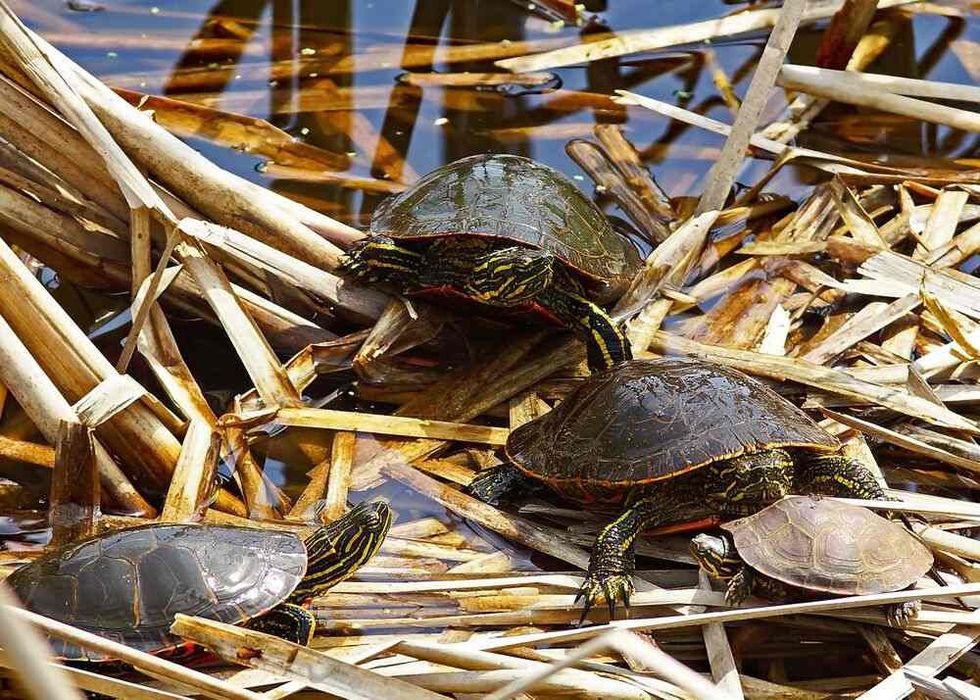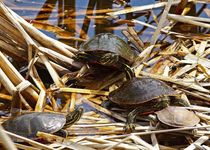How Big Do Painted Turtles Get? Turtle-y Awesome Facts For Kids!

The painted turtle (Chrysemys picta) is the only living member of the genus Chrysemys, which belongs to the Emydidae family of pond turtles.
The painted turtles lived 15 million years ago, according to fossils. The upper shell of the turtle is black and smooth, with no ridges.
It has dark skin and limbs with orange, red or yellow lines. Male painted turtles are smaller than the adult female painted turtle.
Painted turtles are North America's most common native turtle. From southern Canada to northern Mexico, this turtle dwells in slow-moving fresh water.
The painted turtle is only active during the day, when it basks under light for hours, relying on the warmth of its environment. Plants especially aquatic plants and algae, as well as tiny water animals provide a protein rich diet.
Insects, crabs, and fish meat are also part of this turtle's diet. Painted turtles look for water and food while swimming, therefore things that float or can be fastened to the edge of the habitat are ideal.
Aquatic turtles pellets are an excellent basic food, but pets should also consume some fresh green vegetables. On a regular basis dark, leafy greens should be served to pets, which also provide protein and vitamins.
Although animals and large fish commonly eat baby turtles, the thick shells of adult turtles protect them from most predators. Southern painted turtles and the western painted turtles hibernate during the winter, generally at the bottom of the water.
The mating seasons of painted season are spring and fall. A female digs a nest on land and deposits eggs.
Male painted turtles take two to nine years to reach sexual maturity, whereas a female painted turtle takes 6–16 years. There are four subspecies of painted turtles.
These different varieties are the eastern painted turtle, midland painted turtle, southern painted turtle, and western painted turtle with the distinction in the position of the heart. The variations also differ in the habitat of this turtle and the turtle's diet.
The carapace of a painted turtle is made up of 13 distinct bones, which are the scales known as scutes.
The outermost layer of scutes of a turtle sheds as it develops, and is replaced by freshly developed, bigger scutes from underneath. Each painted turtle has a distinct look and color.
The shell of the eastern subspecies is dark olive green with bright red dots on the underside of the upper half of the shell. The midland is identical to the eastern subspecies, but has a deeper yellow coloured patch on the underside.
The southern painted turtle is the smallest and has a red stripe along the length of its shell. The vivid red pattern over much of the underside of the shell distinguishes western painted turtles.
The average painted turtle develops to be 4-12 in (10.1-30.4 cm) long. A painted turtle may live for more than 50 years in the wild and can be seen in small water areas, drying themselves under the sun.
A fully developed painted turtle will be around 6-7 in (15.24-17.78 cm) long, requiring a 60-70 gal (272.7-318.2 l) tank to supply 10 gal (45.4 l) of water and space where the turtle may thoroughly dry off. A baby painted turtle should be given at least 10 gal (45.4 l) of water.
Depending on various factors the growth rates of these reptiles varies. Mostly, a painted turtle makes a very good pet due to its kind and calm nature.
If you enjoyed this article, why not also know or visit to know about why do turtles live so long and what is a group of turtles called, here on Kidadl.
How long does it take for a painted turtle to grow full size?
Turtles typically attain adulthood between the ages of five and eight years. Like the rings in a tree trunk, a turtle also develops rings as it grows old in the back of its shell which is often called scutes.
Typically, this occurs between the ages of three and five. A female attains adulthood when its plastron reaches a length of 3.9-5.1 in (10-13 cm).
They reach maturity between the ages of 6-10 years. They continue to grow after reaching adulthood, although at a slower rate.
Painted turtle grows about 2 in (5 cm) during their early years, but after that, they only grow about 1 in (2.5 cm) every year. They typically grow to be 8-10 in (20.3-25.4 cm) tall, while a female grows to be 10-12 in (25.4-30.4 cm) tall.
The juvenile growth rate of this turtle is around 0.5 in (1.2 cm) each year. After attaining sexual maturity at around 10, the annual growth rate will have dropped to 0.04 in (0.1 cm). A painted turtle would be only a few millimetres long when it first hatches.
By the age of one, the turtle should have grown to around 2 in (5 cm) and by five, it should be roughly 3.1 in (9 cm) long. Painted turtles often achieve sexual maturity at the age of 10.
A turtle's shell would be around 4.7 in (12 cm) long at this age. An average painted turtle's ultimate shell length is 6 in (15 cm).
A mature one ranges in size from 4-10 in (10.1-25.4 cm). They have an average life expectancy of 35-40 years.
How fast do painted turtles grow?
Different turtle species develop at varying speeds. Because most freshwater turtles are tiny to medium-sized, you should anticipate them to grow at a pace of 0.4-0.8 in (1-2 cm) each year.
As youngsters, a painted turtle (Chrysemys picta) develops the fastest. The baby growth rate is around 0.5 in (1.2 cm) each year. After attaining sexual maturity at around 10, the annual growth rate would have dropped to 0.04 in (0.1 cm).
The painted turtle would be only a few millimetres long when it first hatched. By the age of one, the turtle should have grown to around 2 in (5 cm).
At four, the painted turtle should be 3.1 in (8 cm) long. Painted turtles often achieve sexual maturity at 10 years of age. An average painted turtle is 6 in (15 cm).
Adult turtles range in size from 4-10 in (10 to 25 cm). Main painted turtles attain adulthood when their plastron reaches about 2.75-3.7 in (7-9.5 cm). Typically, this occurs between the ages of three and five. They develop at discrete rates, and the temperature during incubation determines its sex.
The threshold has reached about 84 F (28.8 C). They continue to grow after reaching adulthood, although at a slower rate. They have a life expectancy of 35-40 years.

Difference Between Male And Female Painted Turtles
Females are bigger than males, especially the shells, and have flat plastrons. Concave plastrons are found in masculine turtles. They have larger, stockier tails as well as longer front claws.
The front claws that male painted turtles have are longer than those of females. They have long, broad tails, but females have narrow, short tails. The cloacal entrance is lower down the tail and away from the body, and for the females, it is close to the body.
They have longer and broader tails. Females have shorter tails.
Painted turtles that require chilly surroundings are often male because male painted turtles prefer lower temperatures. An incubator should be set at a temperature of about 87 F (30.5 C) for captive breeding. The baby will be probably be male if you lower the temperature as low as 77 F (25 C).
A turtle's plastron is the covering on its underbelly. As mentioned above, a male painted turtle's plastron is curled inwards, whereas a female's is flat. Reproductive activity clearly indicates the sex of a painted turtle. Females are seen laying their eggs from spring. There is a striking difference between the two sexes.
Why wild turtles grow slower than pet turtles?
Wild painted turtles are identical to domestic painted turtles, but their habitat is vastly different and there is a new element that has a significant impact on their growth rate and health.
Wild turtles have it rough and their health is lower compared to pet turtles. This is most likely due to a turtle's diet.
Unlike pet turtles who are properly and regularly fed by their owners, wild turtles must search and scrounge for proper food daily. They won't be able to feed on the same meat-based food that supplies protein and such a balanced diet as pet turtles, therefore their health rate will decrease as a result.
Basking is an essential factor for the growth of a painted turtle since it allows the turtle to adjust its body temperature when exposed to heat or light. A wild turtle benefits more from basking in adequate space than a pet turtle.
They constantly have access to the heat or sunlight, which is actually healthier than most UVB bulbs or light and required for calcium absorption through generation of vitamin D3.
So, when it comes to basking or light absorption, it is more healthy for wild turtles. As a solution, artificial lighting and heating of a turtle tank along with a basking area and plants are provided for pet turtles.
Fluorescent lighting gives a high degree of illumination and should be supplied for pet painted turtles. Age and genetics are almost similar for both of them. The largest variation alongside diet, is due to the weather.
Pet turtles do not have to deal with changing weather because they are usually indoors with constant heat. However, the health of wild turtles can change because they have to deal with the weather, which means they must cope with winter outside.
Painted turtles hibernate throughout the winter, which means they are generally dormant for three to five months every year. As a result, they are less developed. Due to the above mentioned factors, wild turtles grow slower than pet turtles.
How to measure your painted turtle?
Turtles are reptiles that have been around for a long time. The size of the turtle gives an estimation of its age which varies in different species.
It is important to follow a few steps while measuring your painted turtle, because of the position of its lungs behind its shell, placing your turtle on its back might be harmful.
The measurement of the carapace includes stretching the measuring tape from the top edge of the carapace down the middle of the carapace to the bottom edge while holding the turtle securely.
Similarly, the plastron is measured by stretching the measuring tape from the top edge of the plastron down the middle of the plastron to the bottom edge while holding the turtle tightly. To measure the shell's height, a popsicle stick is placed along the hinge of the turtle's plastron.
The ruler is hold vertically and height is measured. All the measurements are taken in inches (centimetres). The weight of the painted turtle is measured with the help of a weighing scale.
The scale should be placed on a stable, firm surface. Then a bowl is placed on the scale and the readings are taken. The measurements should be taken in ounces (grams).
Now, the turtle is placed in the bowl and weighed. Also, counting the total number of annulis or rings gives an estimation of the turtle's age which requires attention and consistency.
Factors Influencing Painted Turtle Growth
The ecosystem, genetics, and environmental conditions have a large influence on the growth of the painted turtle. To a certain extent ,the pH level of the pond or the painted turtle habitat affects its growth as well.
Climatic conditions and ensuring a turtle has a proper diet have a positive effect on the growth rates. Factors like water, ambient air, sex, and basking space will all have an impact on your turtle, influencing the growth of a painted turtle.
Water should be kept between 75-80 F (23.8-26.6 C). Proper diet to a painted turtle is always essential for the growth of the species. While growing within the egg, painted turtles undergo temperature-dependent sex determination.
Eggs exposed to higher temperatures are likely to become female, whereas eggs exposed to lower temperatures are likely to become males. Furthermore, rising average temperatures might result in significant changes in the demography of those species, eventually leading to extinction.
A basking area is an essential factor for the growth of a painted turtle since it allows the turtle to adjust its body temperature and then it is exposed to UVB rays. UVB radiation is needed for the synthesis of vitamin D3, which is required for calcium absorption.
Without UVB radiation, turtles will not be able to obtain the correct amount of calcium, which can lead to bone disease.
Without UVB light, turtles would be unable to effectively utilise the calcium that they store in their bodies, limiting their ability to develop to their full potential.
A good basking area and environment is required for optimal development. These turtles may be found in a broad range of environments across North America.
An environment with clean and fresh water with a soft, muddy bottom are best for them to dwell in. They also require a large number of places to crawl out of the water to bask in the sun, as well as a large amount of flora to attract suitable food.
They can be found in ponds, streams, lakes, rivers, and other slow-moving bodies of water.
Here at Kidadl, we have carefully created lots of interesting family-friendly facts for everyone to enjoy! If you liked our suggestions for how big do painted turtles get then why not take a look at how do turtles sleep or painted turtle facts.
We Want Your Photos!
More for You
Bachelor of Science specializing in Nautical Science

Ayan BanerjeeBachelor of Science specializing in Nautical Science
Thanks to his degree in nautical science from T.S. Chanakya, IMU Navi Mumbai Campus, Ayan excels at producing high-quality content across a range of genres, with a strong foundation in technical writing. Ayan's contributions as an esteemed member of the editorial board of The Indian Cadet magazine and a valued member of the Chanakya Literary Committee showcase his writing skills. In his free time, Ayan stays active through sports such as badminton, table tennis, trekking, and running marathons. His passion for travel and music also inspire his writing, providing valuable insights.
Bachelor of Arts specializing in Economics

Gowri RaoBachelor of Arts specializing in Economics
With a bachelor's degree in Economics from Krea University, Gowri is a highly skilled data analyst and an expert in regression and causation modeling. Her interests in economic trends, finance, and investment research complement her professional expertise. In addition to her professional pursuits, Gowri enjoys swimming, running, and playing the drums, and she is also a talented tutor.
Disclaimer
1) Kidadl is independent and to make our service free to you the reader we are supported by advertising. We hope you love our recommendations for products and services! What we suggest is selected independently by the Kidadl team. If you purchase using the Buy Now button we may earn a small commission. This does not influence our choices. Prices are correct and items are available at the time the article was published but we cannot guarantee that on the time of reading. Please note that Kidadl is a participant in the Amazon Services LLC Associates Program, an affiliate advertising program designed to provide a means for sites to earn advertising fees by advertising and linking to Amazon. We also link to other websites, but are not responsible for their content.
2) At Kidadl, we strive to recommend the very best activities and events. We will always aim to give you accurate information at the date of publication - however, information does change, so it’s important you do your own research, double-check and make the decision that is right for your family. We recognise that not all activities and ideas are appropriate for all children and families or in all circumstances. Our recommended activities are based on age but these are a guide. We recommend that these ideas are used as inspiration, that ideas are undertaken with appropriate adult supervision, and that each adult uses their own discretion and knowledge of their children to consider the safety and suitability. Kidadl cannot accept liability for the execution of these ideas, and parental supervision is advised at all times, as safety is paramount. Anyone using the information provided by Kidadl does so at their own risk and we can not accept liability if things go wrong.
3) Because we are an educational resource, we have quotes and facts about a range of historical and modern figures. We do not endorse the actions of or rhetoric of all the people included in these collections, but we think they are important for growing minds to learn about under the guidance of parents or guardians.







